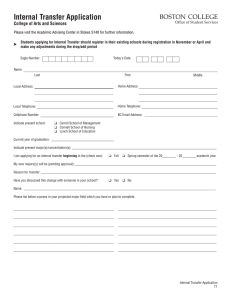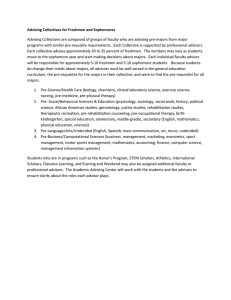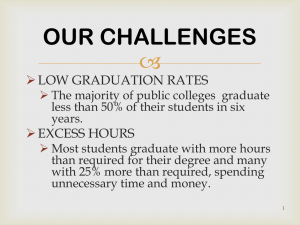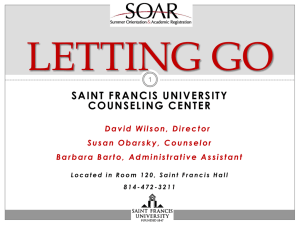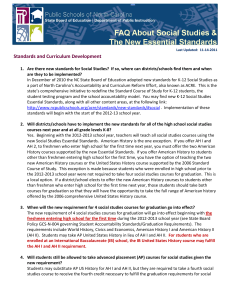Results from the USA Faculty Survey on I. Background
advertisement
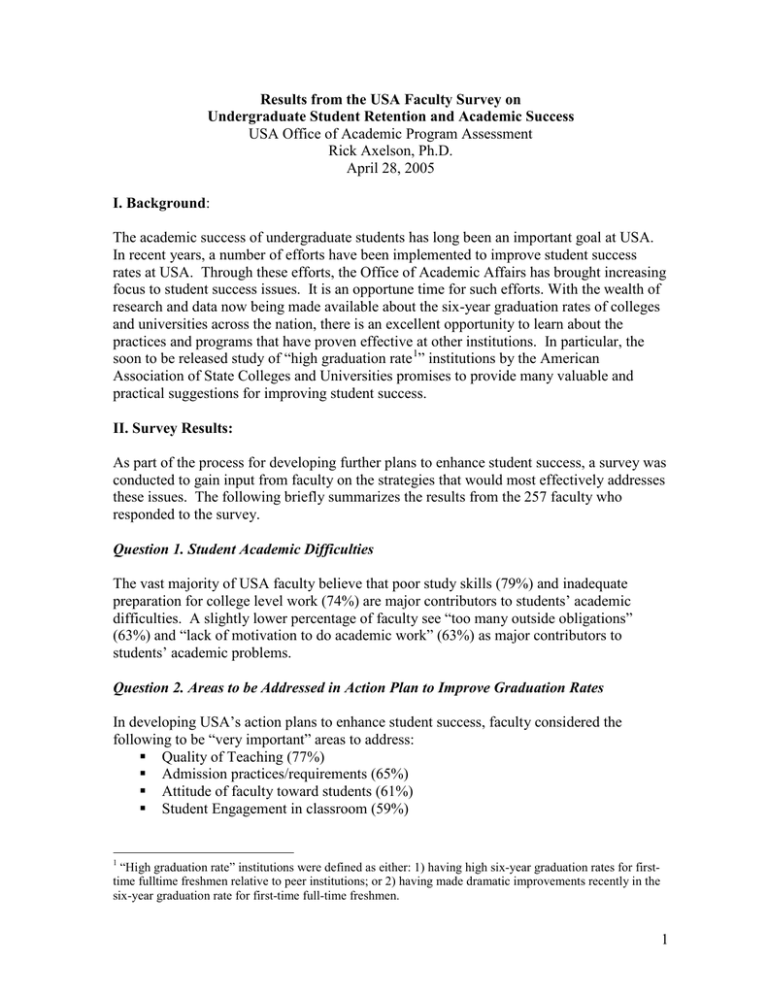
Results from the USA Faculty Survey on Undergraduate Student Retention and Academic Success USA Office of Academic Program Assessment Rick Axelson, Ph.D. April 28, 2005 I. Background: The academic success of undergraduate students has long been an important goal at USA. In recent years, a number of efforts have been implemented to improve student success rates at USA. Through these efforts, the Office of Academic Affairs has brought increasing focus to student success issues. It is an opportune time for such efforts. With the wealth of research and data now being made available about the six-year graduation rates of colleges and universities across the nation, there is an excellent opportunity to learn about the practices and programs that have proven effective at other institutions. In particular, the soon to be released study of “high graduation rate 1” institutions by the American Association of State Colleges and Universities promises to provide many valuable and practical suggestions for improving student success. II. Survey Results: As part of the process for developing further plans to enhance student success, a survey was conducted to gain input from faculty on the strategies that would most effectively addresses these issues. The following briefly summarizes the results from the 257 faculty who responded to the survey. Question 1. Student Academic Difficulties The vast majority of USA faculty believe that poor study skills (79%) and inadequate preparation for college level work (74%) are major contributors to students’ academic difficulties. A slightly lower percentage of faculty see “too many outside obligations” (63%) and “lack of motivation to do academic work” (63%) as major contributors to students’ academic problems. Question 2. Areas to be Addressed in Action Plan to Improve Graduation Rates In developing USA’s action plans to enhance student success, faculty considered the following to be “very important” areas to address: Quality of Teaching (77%) Admission practices/requirements (65%) Attitude of faculty toward students (61%) Student Engagement in classroom (59%) 1 “High graduation rate” institutions were defined as either: 1) having high six-year graduation rates for firsttime fulltime freshmen relative to peer institutions; or 2) having made dramatic improvements recently in the six-year graduation rate for first-time full-time freshmen. 1 Question3. Strategies for Improving Graduation Rates Of the strategies listed in the survey, faculty responded that the following would be “very effective” for improving USA’s graduation rates: Advising interventions with high-risk students (63%) Raising admission standards for first-time freshmen (61%) Requiring developmental studies for high-risk students (57%) Implementing an early warning system (56%) Strengthening the class attendance policy for freshmen (55%) Placing greater emphasis on the importance of teaching excellence (53%) Improving the effectiveness of supplemental instruction (51%) Establishing an Academic Advising Center (50%) Comments to Open-Ended Questions The open-ended comments in the survey help to clarify and extend the above findings. Comments for all three open-ended questions about ways of increasing student success were coded, with minor editing, into the following categories 2: I. Specific Program Recommendations II. General Approaches for Improving Student Success a. Raising Admission Standards b. Raising Expectations about Academic Performance and Students’ Responsibilities c. Ensuring that students have needed skills for Academic Success d. Support for Freshmen Transitioning to College e. Advising, Mentoring, and Tutoring for Students f. Social Integration of Students to Campus Life g. Faculty, Teaching, & Classroom Improvements h. Other Student Issues i. Other Issues III. Discussion: After careful review of the comments and the above survey results, several themes and underlying issues emerged. First, and most fundamentally, from faculty responses (Q.2.) and comments, it is clear that quality teaching, extensive faculty-student contact, and student engagement in classrooms are seen as key areas to consider when developing strategies to enhance graduation and retention rates. Further, the survey comments suggest that it is through improvement of the educational environment that the desired increases in student graduation and retention rates at USA will be achieved. To advance such efforts, faculty provided suggested approaches for addressing some of the current obstacles to student success. One of the most often cited faculty concerns was with 2 The complete set of coded comments is available upon request from raxelson@usouthal.edu 2 remediating students who are not academically prepared for college work. The following approaches were offered to improve the academic preparation levels of USA students: Raising admission standards Expanding remediation efforts in basic skills, particularly for freshmen Expanding use of course prerequisites and placement tests to ensure that students have the needed skills and knowledge for successful course completion Working with high schools to improve preparation for college Closely related to this, was concern with students’ readiness and willingness to put forth the needed effort to succeed in college. Below are some illustrative sample comments. The biggest challenge right now is overcoming poor attitudes about learning by students, especially when faced with simple mathematics (general math and basic algebra) and science courses. A lot of our problems stem from students expecting to be spoon-fed and a feeling that only minimal effort should be required to get an A. These attitudes were instilled in many of these students LONG before they got here (i.e. grade school)…. 1. We can not learn for them 2.We can not teach them if they don't come to class 3. If they do not want to put in the time necessary to succeed, we can not make them If they'd study, they'd pass. There were many comments and suggested remedies related to the various dimensions of this issue. Many of these suggestions focused on having a freshman course/experience to acquaint students with USA’s expectations and to help students find an appropriate niche. Our students don't seem to understand the importance of preparing for their careers and doing well in their coursework. I do believe some sort of Freshman orientation course would go a long way to help with this problem. I also believe that transfer students would benefit from a similar course I like schools that create a good strong system of inquiry of majors for freshman. Some don't even allow freshmen to declare majors but give them experiences during the first year that help them find the appropriate majors for their interest and ability levels. I have advocated a freshman seminar for many years. I have proposed that entering freshmen select one of several interdisciplinary seminars offered each year. The carefully selected faculty member leading such a seminar would become each student's advisor until the student decided upon a major, a decision that should not be made until the second year … State universities in some Midwestern states require all students to take a course on successful student behaviors in their first term… Advising was seen by faculty as a particularly valuable tool for getting and keeping students on the right academic track. Also, as indicated in Q.3., faculty viewed advising interventions with high-risk students as one of the most effective strategies for improving student retention and graduation rates. Similarly, close monitoring and advising for freshmen was noted as important by several respondents. One such respondent wrote: 3 I would like to be able to notify a student's faculty advisor when he/she is in trouble in a class, particularly for first-year students. Conversely, if someone in another dept. warned me that one of my advisees was in trouble, I would definitely address the issue with the student. Of course, I can do this now, but there is not a simple mechanism in place and I'm not always sure that in the larger departments it would do any good for me to contact an advisor. Student effort, in addition to being fueled by finding suitable career and academic interests, is the object of much attention within the classroom. Faculty provided a number of suggestions about making classes more engaging and motivating. Some of the major recommendations were to: Reduce class size Strengthen the class attendance policy (although some expressed concern that punitive approaches to this might actually hurt retention) Place greater importance on teaching excellence in recruitment, promotion, and tenure decisions Respondents also offered a number of tips for retaining and motivating students as shown in the following excerpts. Service-learning can engage students in learning and help them focus their interests. pop quizzes, projects that stimulate competition and classroom discussion Co-op volunteer work in line with course subject material requirements I think developing relationships with students is very important. Often, taking the time to really know your students and making them feel like they have someone to turn to when things get difficult, personally or academically, is core to keeping them here and on target for graduation. Research cites that the affective or emotional role in teaching is essential to teacher effectiveness. Too often university professors and instructors teach only the content and not students. Students need to know that we really care about their overall success. I have found that in my beginning classes, when I place more emphasis on study skills and the basic approach to learning in my discipline, students do better. My attendance policy is also very strict (points are awarded every day for preparation and participation, so an absence is a zero) and this is also helpful. Maintaining class size to the point where students feel like members, not anonymous numbers - where faculty can interact with a significant proportion of class members at each class meeting, making the experience "personal." Letter grading of all quizzes and term tests Apparently at-risk students in our department have responded very favorably to more personal attention on the part of advisors or other faculty members. This involves simple face-to-face conversations about goals, study methods, and perceived obstacles to learning. Students seem very much encouraged to know that faculty are concerned about their success. 4 Although the majority of comments focused on students’ academic preparation and performance, some respondents mentioned that social networks among student, graduate students, and faculty offered valuable support for students. They suggested that the availability of casual meeting areas would support the development of more social interaction. Lastly, faculty identified a number of specific programs which should be considered in the development of USA’s plans to improve retention and graduation rates. USA Programs/Practices that appear to be working: o Essence o USA Honors Program o Study Skills seminars in History Department o Supplemental Instruction Programs/Practices at Other Institutions that appear to be effective: o Columbus State University’s Advising/Placement Center (SAFE Office) – very good o University of Southern Mississippi has an outstanding Orientation day for incoming freshmen o LSU had a whole division dedicated to remediation (don’t know how successful it was) o Spring Hill College had an attendance policy > after second absence, students were sent a warning notice; after the third absence, they were dropped from the class by the instructor o Georgia Southern University – freshmen required to take two one-hour courses – study skills, resources available on campus. o University of Texas at Austin’s Gateway Program assists incoming atrisk freshmen by offering them smaller classes with extra tutoring. o University of Texas at Austin’s Freshmen Interest Groups (FIGs) – small, one-credit hour seminars designed to help freshmen integrate into the University – heard many enthusiastic comments about them. o Ohio State University has a one-term course that introduces students to the university, including the campus, administration, advising, and the library – would be extremely helpful here. o FSU is very successful recruiting and retaining natural science majors with field trips and other field-based “hands-on” approaches o Spring Hill College had a Summer Developmental Program for at-risk students. Students took composition, history, and study skill courses. 5
